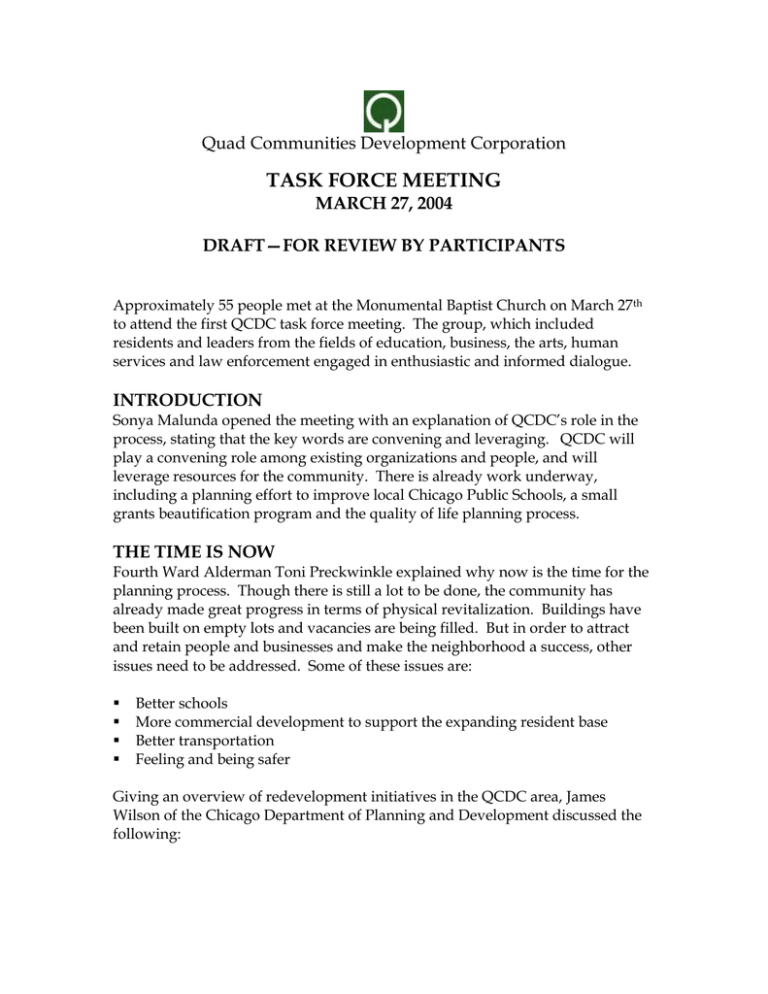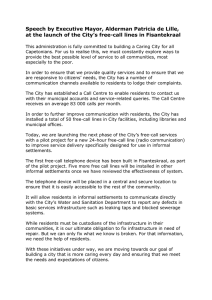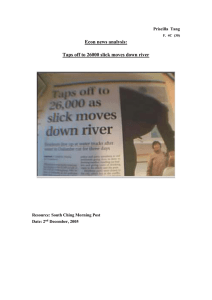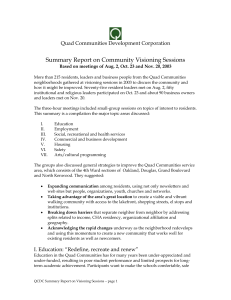TASK FORCE MEETING Quad Communities Development Corporation MARCH 27, 2004
advertisement

Quad Communities Development Corporation TASK FORCE MEETING MARCH 27, 2004 DRAFT—FOR REVIEW BY PARTICIPANTS Approximately 55 people met at the Monumental Baptist Church on March 27th to attend the first QCDC task force meeting. The group, which included residents and leaders from the fields of education, business, the arts, human services and law enforcement engaged in enthusiastic and informed dialogue. INTRODUCTION Sonya Malunda opened the meeting with an explanation of QCDC’s role in the process, stating that the key words are convening and leveraging. QCDC will play a convening role among existing organizations and people, and will leverage resources for the community. There is already work underway, including a planning effort to improve local Chicago Public Schools, a small grants beautification program and the quality of life planning process. THE TIME IS NOW Fourth Ward Alderman Toni Preckwinkle explained why now is the time for the planning process. Though there is still a lot to be done, the community has already made great progress in terms of physical revitalization. Buildings have been built on empty lots and vacancies are being filled. But in order to attract and retain people and businesses and make the neighborhood a success, other issues need to be addressed. Some of these issues are: Better schools More commercial development to support the expanding resident base Better transportation Feeling and being safer Giving an overview of redevelopment initiatives in the QCDC area, James Wilson of the Chicago Department of Planning and Development discussed the following: Madden Wells Redevelopment will be coming out of the ground soon and will have 3,000 units. One third will list at market rate, one third will be affordable and one third will be rented to CHA residents. Construction on the first 200 rentals begins in May. Jazz on the Boulevard will have 137 units with 50% at the market rate, 25% affordable and 25% reserved for CHA. Construction will start this spring. Lakefront Properties has 490 units and like Jazz on the Boulevard will have a 50/25/25 split. The first units will be available to tenants in May. Construction of 24 condominium units at 39th and Ellis. Agreeing with Alderman Preckwinkle that the time is now, Mr. Wilson noted that the private sector, market driven activity ranks the area among the busiest in the city in terms of housing construction. By Mr. Wilson’s count, there are a total of 5,000 units either in construction or in legislative process for construction. In response to concerns voiced by Harold Lucas that the targeted area is too narrow and that the process is politically focused and not inclusive of lowincome people, Alderman Preckwinkle replied that she could not plan for another ward, so it doesn’t make sense to go outside the 4th Ward. The south and north ends of the Ward don’t need the attention so much as the middle does. Additionally, through a series of community meetings held last fall, an effort was made to include all elements of the community. Alderman Preckwinkle added that she would take suggestions on others who should be a part of the process. With the exception of the construction of public housing transformation, Muntu Dance Theatre and the Lake Park Points Shopping Center, the community has been rebuilt without residential displacement, Alderman Preckwinkle noted. As part of the CHA Transformation process, residents can return to mixed-income developments. THE PLANNING PROCESS Les Pollock of Camiros gave an overview of the planning process that included a PowerPoint presentation. Ideally, the task force as a whole entity will have a total of six meetings. The identification of issues takes place at the first meeting. At the second meeting, the task force forms its subcommittees. Subcommittees will be expected to meet and work out strategies for their particular issue area to bring forward to the larger task force meetings. The task force is then charged with developing a vision and forming strategies that will bring the vision to life. The fourth meeting will involve fine-tuning strategies and picking projects and programs. This will be followed by a project review meeting, drafting of the plan by scribes and planners, setting roles and a ratification meeting. The final plan will consist of four to five chapters, which will include an introduction and chapters on the vision, challenges, strategies and projects, and program implementation. DISCUSSION OF ISSUES At the three meetings held last fall, several issues concerning the community were raised and documented. At this first task force meeting, the question “What is missing?” was asked of participants. Several topics emerged. Though many of these issues had come up at prior meetings, members felt that they needed to be expanded upon and further developed. The topics are: EDUCATION YOUTH DEVELOPMENT, EMPOWERMENT AND EMPLOYMENT TRANSPORTATION RELIGIOUS INSTITUTIONS INFRASTRUCTURE ENTERTAINMENT HERITAGE TOURISM EDUCATION The concern is that current residents don’t have access to schools in the neighborhood that have seen new development, nor do they have access to “better” schools that are new to the community. Of particular concern are King High School and Ariel Career Academy. Students who didn’t meet the standards when King was named a college preparatory school were sent to Dyett or Phillips High, which many contend is now chaotic because of gang turf wars. “The perception of many low-income people is that they are not being served by the educational system. Something new comes to the neighborhood and people who have lived here for years don’t trust it because they’ve had nothing to do with it. This issue of perception needs to be addressed.” Conrad Worrill The contention that the Mid-South schools planning effort was not created for current residents was challenged by Shirley Newsome and Rebecca Janowitz, who are both a part of that process. The focus of the schools planning group is to make the community schools better for the community. If residents are in the attendance area of the school, then their children should be able to attend the school. It was suggested that there be forums on education to address the concerns of long-term residents who feel threatened and left out by the changes taking place. YOUTH DEVELOPMENT, EMPOWERMENT AND EMPLOYMENT Several participants said that the youth in the community need so much more than what is available to them now. There is a strong feeling that they’re being lost to the perils of the streets and that they won’t grow into productive citizens. Many young men don’t even see education as an option to attaining a good life. The community needs something that will engage the youth early on and let them know that they have choices. It was suggested that something beyond the traditional boys-and-girls club and parks is needed. Suggestions include: Developing programs that will teach them about choices, quality of life issues and give them vision Encouraging civic involvement so they know that they help shape the community Encouraging volunteerism Emphasizing community history in the educational curriculum Creating year-round jobs for teens, something that will last longer than the summer and will give them an alternative to gangs Using grassroots efforts and working with individual families to encourage youth to go to school TRANSPORTATION The community needs more choices when it comes to public transportation. The need for more alternatives is growing with the growth of the community. Suggested options are: As there are no stops on the Electric Line between 27th and 47th streets, reopen the Metra station at 39th. Improve bus routes in area by extending hours and route of 43rd Street bus, which only runs until 7 p.m. and doesn’t run on Sundays. Additionally, the planned overpass at 43rd Street will need a good feeder service to the park. Achieve access to federal T-21 funds (highway bill), which could provide funding for jitney service. Reverse commuting services (transportation that is specifically for picking up residents and taking them to far-off job sites). RELIGIOUS INSTITUTIONS Religious institutions can be helpful in the planning process and can benefit from the process at the same time. By utilizing them, we can also help them. Assist in beautification efforts Encourage new residents to worship in the community with welcoming activities Use church facilities as community facilities (meeting space, daycare), thereby helping defray expensive maintenance costs Enhance the capacity of churches to do development (housing, community betterment) Coordinate church outreach to senior buildings INFRASTRUCTURE As the community grows and development increases, the infrastructure of the area needs to be kept in mind. If the infrastructure isn’t maintained or is weakened, then all of the commercial and housing development won’t survive. The following should be maintained, upgraded or in some instances, replaced as development happens throughout the community: Streets, curbs, gutters Water systems, sewers Street lighting Additionally, respect for maintenance of public and open spaces should be kept in mind, while expanding the number of functioning block clubs to enforce civil culture, e.g. picking up garbage and cleaning up after dogs. ENTERTAINMENT Entertainment venues could be used to draw people to the area and sustain the economy. While keeping congestion to a minimum, an entertainment district consisting of theaters, nightclubs, cyber cafes and sports bars could be developed. “We want all the things here that people get into their cars and drive to the North Side for.” Eric Stackhouse HERITAGE TOURISM DEVELOPMENT Cultural tourism should be a priority in the planning process. The area has a rich history and culture and it needs to be used to its best advantage to bring people into the community. Capitalizing on available funds and integrating into regional efforts, efforts could: Make area a tourist destination by using Black Metropolis heritage Use the community’s proximity to Sox Park as a draw Leverage the community’s connection to McCormick Place Other issues that were raised or reiterated include: Environmental protection and education Political action as a community development tool Make health and safety separate issues Economic empowerment of local people and youth Senior programs Use technology as a tool: “digital network infrastructure” to connect people in the community In addition to the issues raised, there were concerns around gentrification and its implications and that the planning process seems to be more of a top-down one instead of a bottom-up one. Other residents responded that the plan will be a diagram of the community’s vision for its future and will be composed of ideas from community residents and leaders. Ray Bentley, the new NCP Director was introduced and will facilitate the process going forward. The full task force’s next meetings will be held on April 17th and May 15th. A larger community meeting is planned, but no date was set. Direct comments to: Ray Bentley NCP Director Quad Communities Development Corporation 773.702.6607 ray361@hotmail.com Or to: Lisa G. Riley NCP Scribe 773.472.8261 auteurauteur@aol.com




